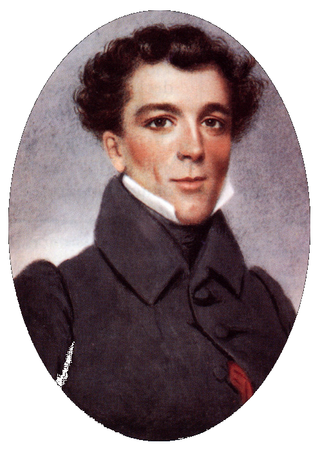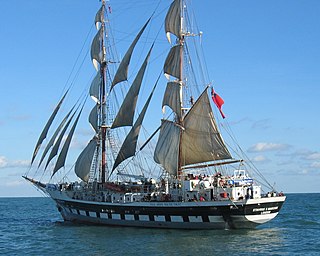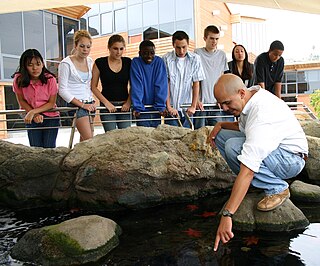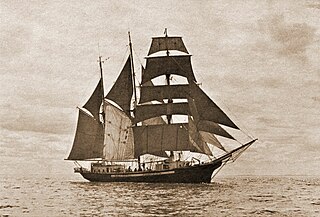
A brig is a type of sailing vessel defined by its rig: two masts which are both square-rigged. Brigs originated in the second half of the 18th century and were a common type of smaller merchant vessel or warship from then until the latter part of the 19th century. In commercial use, they were gradually replaced by fore-and-aft rigged vessels such as schooners, as owners sought to reduce crew costs by having rigs that could be handled by fewer men. In Royal Navy use, brigs were retained for training use when the battle fleets consisted almost entirely of iron-hulled steamships.

Richard Henry Dana Jr. was an American lawyer and politician from Massachusetts, a descendant of a colonial family, who gained renown as the author of the classic American memoir Two Years Before the Mast and as an attorney who successfully represented the U.S. government before the U.S. Supreme Court during the Civil War in the Prize Cases. Both as a writer and as a lawyer, he was a champion of the downtrodden, from seamen to fugitive slaves and freedmen.

Two Years Before the Mast is a memoir by the American author Richard Henry Dana Jr., published in 1840, having been written after a two-year sea voyage from Boston to California on a merchant ship starting in 1834. A film adaptation under the same name was released in 1946.

USS Santee was a wooden-hulled, three-masted sailing frigate of the United States Navy. She was the first U.S. Navy ship to be so named and was one of its last sailing frigates in service. She was acquired by the Union Navy at the start of the American Civil War, outfitted with heavy guns and a crew of 480, and was assigned as a gunboat in the Union blockade of the Confederate States. She later became a training ship then a barracks ship for the U.S. Naval Academy.

Robert Bennet Forbes, was an American sea captain, China merchant and ship owner. He was active in ship construction, maritime safety, the opium trade, and charitable activities, including food aid to Ireland, which became known as America's first major disaster relief effort.

USS Bugara (SS-331), a Balao-class submarine in commission from 1944 to 1970, was a ship of the United States Navy named for the bugara, a multicolored fish found along the coast of California.

Stavros S Niarchos is a British brig-rigged tall ship, now renamed "Sunset". She was previously owned and operated by the Tall Ships Youth Trust (TSYT). She was primarily designed to provide young people with the opportunity to undertake voyages as character-building exercises, rather than pure sail-training. She was also used for adult voyages and holidays, which helped subsidise the operation of the ship.

A jackass-barque, sometimes spelled jackass bark, is a sailing ship with three masts, of which the foremast is square-rigged and the main is partially square-rigged and partially fore-and-aft rigged (course). The mizzen mast is fore-and-aft rigged.

SS Adriatic was the first of two White Star Line ocean liners to carry the name Adriatic. The White Star Line's first four steamships of the Oceanic-class, the met with great success in the trans-Atlantic market, and the line decided to build two more. The first of these was the SS Adriatic, which was built by Harland and Wolff and launched on 17 October 1871; the second was the SS Celtic.

The Ocean Institute is an ocean education organization located in Dana Point, California. Founded as the Orange County Marine Institute in 1977, it offers ocean science and maritime history programs for K–12 students and their teachers. Over 100,000 students and 8,000 teachers from Orange County and the surrounding counties participate yearly in immersion-style programs in the institute's oceanfront labs and abroad.
The Advance was a composite schooner built in 1874 at Auckland, New Zealand, that was wrecked when she drifted onto rocks at Henrys Head, Botany Bay, New South Wales, Australia, on 12 June 1902, whilst carrying ballast between Wollongong and Newcastle, New South Wales.

The American sailing ship Regina Maris was originally built as the three-masted topsail schooner Regina in 1908. She was a 144-foot (44-meter), wooden, completely fore-and-aft–rigged sailing ship with three masts. She was re-rigged in 1963 as a 148-foot (45-meter) barquentine. Regina Maris could reach a speed of up to 12 knots, especially on a half-wind course or with a fresh back-stay breeze.
Thomas Humphrey Metcalfe was an American maritime fur trader who worked with his father, Simon Metcalfe. After being separated from his father in a storm, Thomas sailed a small schooner with a crew of four from the vicinity of China to Nootka Sound on Vancouver Island where he was arrested by the Spanish. After being released he sailed to Hawaii, hoping to find his father. Instead, he was attacked and killed by Native Hawaiians in revenge for misdeeds committed by his father just days before.

William Doliber Gregory was an American sea captain born in Marblehead, Massachusetts. Gregory was captain of the clipper ship Tejuca from her 1854 completion to her foundering and sinking in an 1856 hurricane; Gregory and most of his crew were rescued only at the last moment by the courageous intervention of a passing ship. Gregory was later commander of the bark Albers, and in 1857 is said to have put down a riot on his ship virtually singlehanded.
This glossary of nautical terms is an alphabetical listing of terms and expressions connected with ships, shipping, seamanship and navigation on water. Some remain current, while many date from the 17th to 19th centuries. The word nautical derives from the Latin nauticus, from Greek nautikos, from nautēs: "sailor", from naus: "ship".
Nautical operations refers to the crew operation of a ship. It is the term used in academic education to refer to the studies of this professional field. Nautical operations refers to all the operational procedures, specific roles of officers and crew members, and regular functions and technical processes, which together shape the structure and functions for the general operations of a ship.
Cadmus was built in 1816 at Medford, Massachusetts. She made five complete voyages as a whaler, one out of Boston (1822–1825), and four out of Fairhaven, Massachusetts (1831–1841). She was lost in 1842 on an uncharted atoll in the Tuamotu Archipelago, that for a time was known as Cadmus Island, and is now known as Morane.













